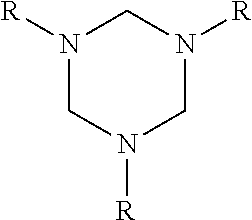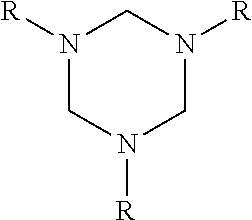Scale Deposition Inhibiting Scavenger Compositions And Their Use
a technology of scavenger compositions and compositions, which is applied in the direction of quary waste water treatment, specific water treatment objectives, separation processes, etc., can solve the problems of scale deposition that affects the performance of oilfield equipment, reduces the effectiveness of h/sub>2/sub>s scavenger components, and reduces the amount of scale inhibitor compositions required to attempt to control the scale deposition. , to achieve the effect of increasing the proportion of solid
- Summary
- Abstract
- Description
- Claims
- Application Information
AI Technical Summary
Benefits of technology
Problems solved by technology
Method used
Image
Examples
example 1
r Test
[0053]Table 1 shows various example formulations A-C and comparative formulations D and E. All formulations showed at least 55′% triazine activity.
TABLE 1CompositionComponentABCDETriazine9590959095scavengerTerpolymer 1510Terpolymer 25Phosphonate 110Antiscale 15
[0054]The determination of the efficiency of scale inhibition, for the control of carbonate and / or sulphate scaling, was performed by a static jar technique at ambient pressure.
[0055]Visual observations and determination of the level of scale was made after 1, 2, 4 and 24 hours. Observations included visual observations of scale formed, and analysis of the scaling ions using Inductively Coupled Plasma Mass Spectrometry (ICP).
[0056]A static scale jar test gives an indication (at atmospheric pressure) of the minimum scale inhibitor concentration (MIC) required to prevent scaling, by observation of the degree of scale formed both with and without scale inhibitor. In order to achieve controlled scaling, the scaling test brin...
example 2
[0064]A static jar test was undertaken using the protocol as set out in Example 1 but using test fluid taken from an oilfield site. The test fluid already contained some scale inhibitor component so a comparative test with no addition of the composition of the present invention was also undertaken. The following tests were undertaken.
[0065]1. Oilfield fluid (Blank-1)
[0066]2. Oilfield fluid+1500 ppm triazine scavenger (Blank-2)
[0067]3. Oilfield fluid+1500 ppm composition A (table 1 above)
[0068]4. Oilfield fluid+1500 ppm composition B (table 1 above)
[0069]5. Oilfield fluid+1500 ppm composition C (table 1 above)
[0070]6. Oilfield fluid+1500 ppm composition D (table 1 above)
[0071]Analysis was by visual observation as in Example 1 and also by ICP analysis of the scale deposit. Visual results are shown in table 4 below, wherein:
[0072]0=Clear Water—No Scaling
[0073]1=Hazy water
[0074]2=Scaling
[0075]3=Thick Precipitation at the bottom.
TABLE 4Time after test start (hours)Test number024241000120...
PUM
| Property | Measurement | Unit |
|---|---|---|
| temperature | aaaaa | aaaaa |
| concentrations | aaaaa | aaaaa |
| pressure | aaaaa | aaaaa |
Abstract
Description
Claims
Application Information
 Login to View More
Login to View More - R&D
- Intellectual Property
- Life Sciences
- Materials
- Tech Scout
- Unparalleled Data Quality
- Higher Quality Content
- 60% Fewer Hallucinations
Browse by: Latest US Patents, China's latest patents, Technical Efficacy Thesaurus, Application Domain, Technology Topic, Popular Technical Reports.
© 2025 PatSnap. All rights reserved.Legal|Privacy policy|Modern Slavery Act Transparency Statement|Sitemap|About US| Contact US: help@patsnap.com


